Fascinating Types of Ducks – Dive into the Diversity
Ducks are undoubtedly one of the most intriguing and diverse groups in the waterfowl world. These charming creatures have captured our imaginations with their graceful movements on water and their often vibrant plumage. With many different types of ducks in the US, let’s delve further into this interesting family.
Ducks belong to the Anatidae family, which also includes geese and swans. With their webbed feet and specialized bills, ducks have evolved to thrive in aquatic and terrestrial environments.
General overview of ducks as a diverse group of waterfowl
Ducks come in all shapes and sizes, from small teals to large diving ducks like mergansers. They display an array of captivating colors, patterns, and markings that add beauty to wetlands around the world.
Their distinguishing features include streamlined bodies, waterproof feathers, and bills designed for various feeding strategies. Some species are expert divers, while others prefer dabbling at the surface or grazing on land.
Importance of ducks in various ecosystems
Ducks play a vital role in maintaining the delicate balance within the ecosystems they inhabit. As omnivorous feeders, they help control populations of insects, mollusks, crustaceans, aquatic plants, and seeds through their foraging activities. Furthermore, their frequent movements between different habitats disperse seeds across vast distances, contributing to plant dispersal and biodiversity enhancement.
Classification of Ducks
The Anatidae Family: Ducks, Geese, and Swans
Ah, the majestic Anatidae family! These exquisite creatures encompass a remarkable variety of waterfowl, including our beloved ducks, geese, and swans. Picture a tranquil pond or a serene lake – chances are you’ll spot these charismatic birds gliding effortlessly across the water’s surface, enchanting onlookers with their elegance.
The Anatidae family is known for its unique adaptations that allow them to thrive in aquatic environments. With their webbed feet and waterproof feathers, they have evolved to navigate the air and water with astonishing grace.
How Ducks Stand Out Among Waterfowl
Now, let’s dive into what distinguishes ducks from their fellow avian companions in the Anatidae family. While geese and swans are undoubtedly eye-catching in their own right, ducks have captivated human fascination throughout history. One key distinguishing feature is their body shape – ducks typically have shorter frames with shorter necks than geese and swans.
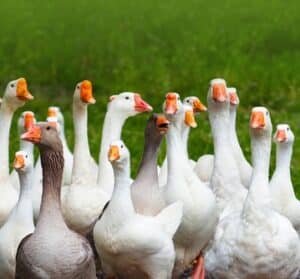
This sleek physique allows them to take off swiftly from water surfaces while maintaining agility during flight. Their beaks also offer subtle variations worth noting. While geese possess broader bills designed for grazing on grasses, swans boast elongated necks equipped for reaching aquatic vegetation deep below the surface, and ducks have developed specialized bills suited for dabbling or diving after prey.
These adaptive traits make them exceptional hunters as they search for insects, small fish, mollusks, or plants to satisfy their voracious appetites. In essence, by understanding the classification within the Anatidae family and recognizing what distinguishes these delightful creatures from other waterfowl species, such as geese and swans, we unlock a deeper appreciation for these fascinating beings who have graced our wetlands and waterways since time immemorial.
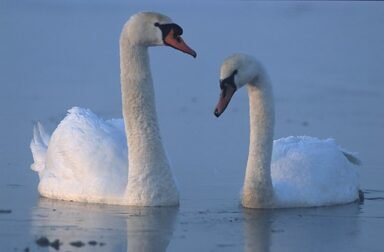
Mallards: The Quintessential Duck
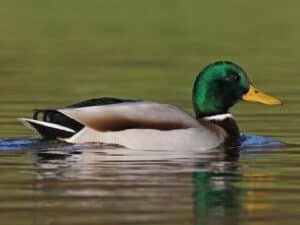
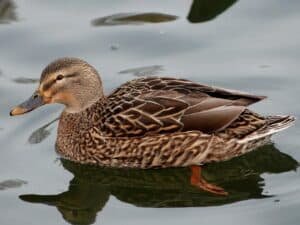
Mallards are perhaps the most recognizable ducks, sporting a vibrant green head and a distinct yellow bill. Their charming appearance has made them the quintessential image of ducks. One intriguing aspect of mallards is their sexual dimorphism, meaning that males and females have different physical characteristics.
The males, known as drakes, showcase a glossy green head with a white neck ring and a yellow bill. In contrast, female mallards, called hens, possess mottled brown plumage with an orange bill.
Regarding behavior, mallards are dabbling ducks that feed mainly on plants in shallow water by tipping their heads underwater while their bodies remain buoyant. They also have an amusing habit of “up-ending,” submerging their entire rear half into the water while keeping their heads up to nibble on aquatic vegetation.
Mallards are adaptable in habitats and can be found in various environments throughout North America and Eurasia. They favor wetlands, ponds, lakeshores, and even urban parks or golf course ponds if suitable resources are available.
Wood Ducks: Nature's Artwork
When it comes to beauty amongst ducks, wood ducks take center stage with their stunningly patterned plumage. These beautifully adorned birds are commonly found in woodland areas near lakes or ponds bordered by trees.
What sets them apart from other duck species is their fascinating nesting habits.
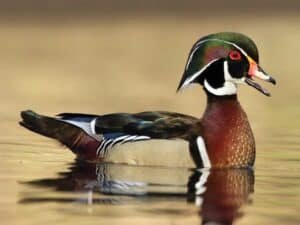
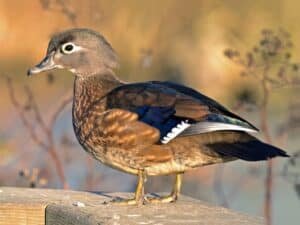
Wood ducks have unique tree cavity selection behavior for nesting purposes.
Females seek out natural tree cavities or abandoned woodpecker holes high above the ground near water bodies. This nesting strategy provides protection for vulnerable eggs and ducklings against predators.
In terms of physical features, wood ducks possess intricate patterns on their feathers, with males sporting a combination of metallic purples, greens, and iridescent chestnut colors. Females have more subdued plumage with gray-brown tones and distinctive white teardrop-shaped markings around their eyes.
Pintails: Graceful Waterfowl
Pintails are known for their elegance, characterized by long, slender necks and pointed tails. These graceful ducks are found in the Northern Hemisphere and parts of South America. They exhibit fascinating migratory patterns, traveling vast distances between their breeding grounds in the northern regions and wintering areas further south.
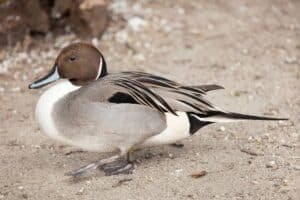
Regarding breeding grounds, pintails typically choose shallow wetland environments to build nests on the ground or nest islands floating amidst water bodies. Regarding feeding habits, these dabbling ducks primarily consume plant matter such as seeds, stems, and leaves found in fields or marshy areas.
Teals: Small Ducks with Vibrant Colors
Teals belong to small-sized dabbling ducks known for their striking plumage variations. One prominent member is the blue-winged teal that showcases its vibrant blue wing patch during courtship displays. These ducks undertake impressive migration routes across North America from their breeding grounds in the northern regions to wintering habitats in the southern United States or Central America.
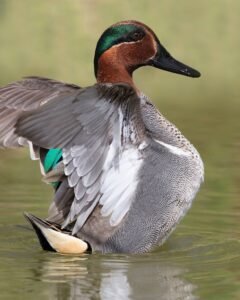
Another intriguing teal species is the cinnamon teal, which prefers marshy habitats rich in aquatic vegetation. Their name stems from the cinnamon-brown plumage displayed by males during the breeding season, while females maintain a more subdued mottled brown appearance throughout the year.
With such diverse characteristics and behaviors exhibited by mallards, wood ducks, pintails, and teals, among many other duck species worldwide, it’s clear that these waterfowl hold a special place within our ecosystems and capture our hearts with their unique charm.
Rare or Lesser-Known Duck Species
Harlequin Ducks: Colorful sea ducks found along rocky coastlines
When it comes to eye-catching waterfowl, the Harlequin duck takes the spotlight. These vibrant sea ducks boast a stunning combination of colors, including slate blue, chestnut, and white. You’ll usually find them bobbing along rocky shorelines, making their home in turbulent coastal waters.
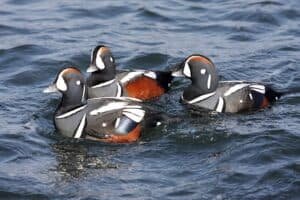
Unfortunately, these beautiful creatures face a concerning threat – habitat loss due to pollution and coastal development. We must work towards preserving their habitats and protecting these magnificent birds.
Mating rituals involving complex displays
Male Harlequin ducks are known for their elaborate courtship displays during the breeding season. They engage in intricate ritualistic behaviors that involve head-throws and wing-flapping while emitting musical calls to attract females.
These enchanting displays demonstrate not only their physical prowess but also their dedication to finding a suitable mate. It’s truly a spectacle of nature that showcases the beauty and complexity of avian courtship.
Hooded Mergansers: Unique-looking diving ducks with distinctive crests
One glance at the Hooded Merganser will captivate you by its unique appearance. These diving ducks possess striking black-and-white plumage with an eye-catching crest atop their heads resembling an elegant fan. Fascinatingly enough, these crests can be raised or lowered based on the bird’s mood or level of excitement!
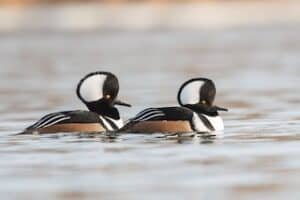
In terms of nesting habits, they have an affinity for tree cavities or nest boxes rather than constructing nests from scratch like many other species.
Fascinating courtship displays involving head movements
When wooing potential mates, male Hooded Mergansers perform captivating courtship displays involving intricate head movements and crests fully extended. These displays can include dramatic head-throwing or curious side-to-side movements, all while emitting soft calls to attract females. It’s a mesmerizing sight to witness these waterfowl engaging in such elaborate rituals, emphasizing the importance of courtship in their reproductive success.
Conclusion
Among the vast diversity of ducks worldwide, some lesser-known species deserve our attention and conservation efforts. The Harlequin duck and Hooded Merganser exemplify nature’s artistry with their striking appearances and captivating behaviors.
However, we must also acknowledge the challenges they face due to habitat loss and environmental changes. By raising awareness about these remarkable creatures and protecting their habitats, we can contribute to ensuring a brighter future for these unique ducks and celebrate the beauty of our natural world.

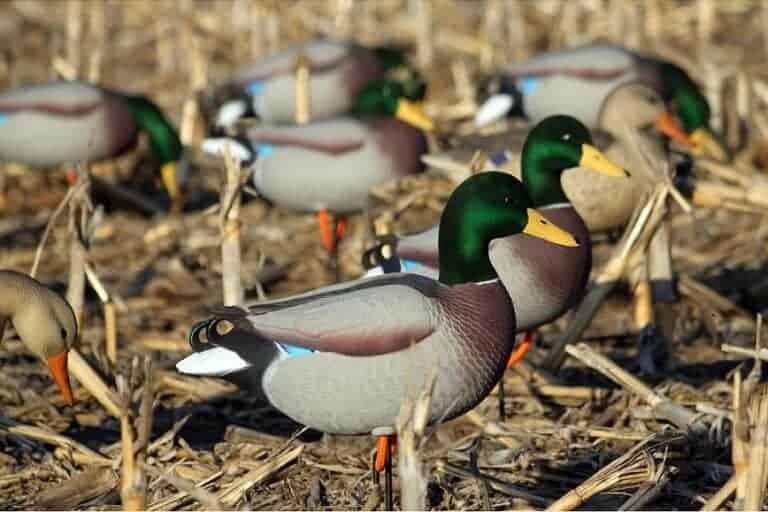
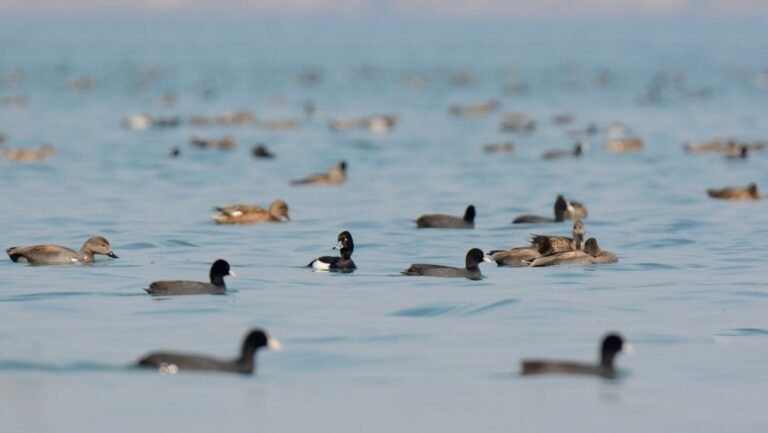
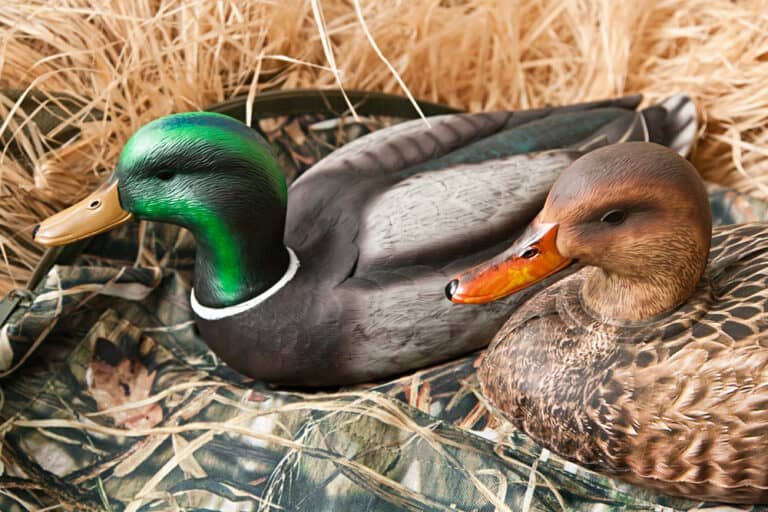


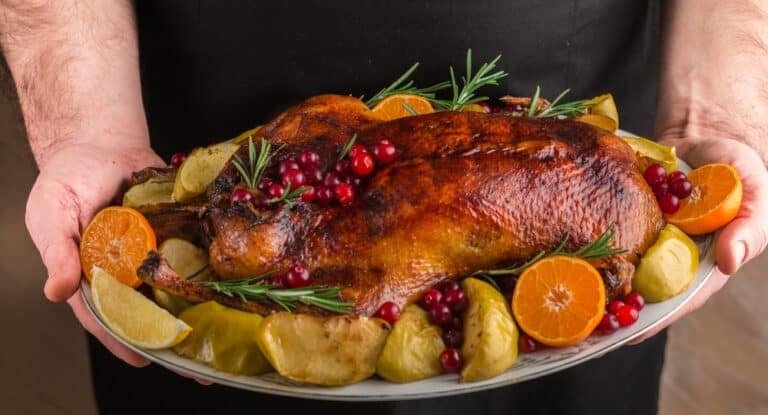
Bottega Veneta — это итальянский бренд, известный неповторимым стилем. Основанный в 1966 году, бренд стал символом лаконичной роскоши и славится классическими аксессуарами. Дизайны бренда отражают высокое мастерство, а также превосходное качество материалов.
Коллекции Fendi на официальном сайте Bottega Veneta
Good day! Do you know if they make any plugins to help with
SEO? I’m trying to get my site to rank for some
targeted keywords but I’m not seeing very good success.
If you know of any please share. Appreciate it! You can read
similar text here: Eco product
Flynn, John L. (1995).
sugar defender ingredients Integrating Sugar Defender
right into my everyday regimen overall health. As somebody who prioritizes healthy consuming, I value the added protection this supplement offers.
Considering that beginning to take it, I’ve noticed a significant enhancement in my energy levels and a substantial
decrease in my need for unhealthy treats such a such a profound effect on my day-to-day live.
https://winteringhamprimary.co.uk/service/util/logout/CookiePolicy.action?backto=https://gamezthai.weebly.com/
Hey there! I just wish to give you a big thumbs up for your excellent info you’ve got here on this post. I will be returning to your website for more soon.
Spot on with this write-up, I honestly think this site needs a great deal more attention. I’ll probably be returning to read through more, thanks for the advice.
Spot on with this write-up, I absolutely think this site needs a great deal more attention. I’ll probably be returning to see more, thanks for the advice!
I seriously love your website.. Great colors & theme. Did you develop this web site yourself? Please reply back as I’m attempting to create my own website and would love to know where you got this from or what the theme is called. Kudos!
Your style is really unique compared to other folks I have read stuff from. Thank you for posting when you’ve got the opportunity, Guess I’ll just bookmark this page.
Hey there! I just would like to give you a big thumbs up for the excellent information you have got right here on this post. I will be coming back to your site for more soon.
стоимость продвижения веб сайта
Hi there! This post couldn’t be written any better! Reading through this article reminds me of my previous roommate! He constantly kept talking about this. I am going to forward this article to him. Fairly certain he’ll have a good read. Thank you for sharing!
Hi! I simply wish to offer you a huge thumbs up for the great information you have here on this post. I will be returning to your website for more soon.
I’m impressed, I have to admit. Rarely do I come across a blog that’s both equally educative and interesting, and without a doubt, you’ve hit the nail on the head. The problem is something not enough men and women are speaking intelligently about. Now i’m very happy I stumbled across this during my search for something regarding this.
An intriguing discussion is definitely worth comment. I do think that you need to publish more about this subject matter, it may not be a taboo matter but usually people do not speak about such issues. To the next! Cheers.
Nice post. I learn something totally new and challenging on blogs I stumbleupon every day. It will always be interesting to read articles from other writers and use something from their websites.